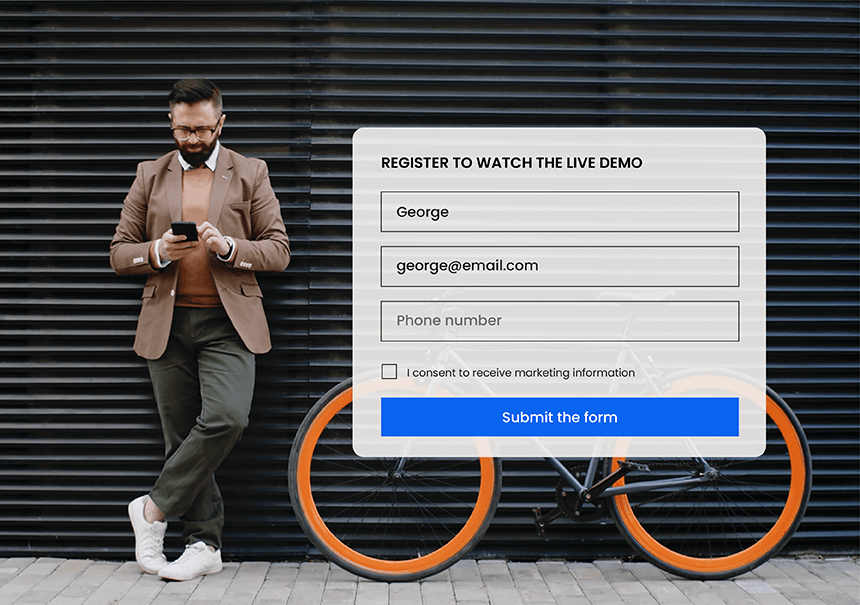The role of contact forms: automation and lead generation

Effective lead generation and effective communication with potential customers become key elements of success. In this context, contact forms play an important role, not only collecting contact data, but also automating processes and personalizing communication. Let’s discover why contact forms are an essential tool for every marketer.
The impact of contact forms on the effectiveness of marketing activities.
Contact forms are a key tool in the arsenal of a self-respecting marketer. Thanks to them, you not only collect basic contact details of potential customers, but also initiate a dialogue from the beginning – and this is crucial for building commitment and loyalty.
Forms are invaluable in personalizing communications with customers, enabling you to better understand their needs and preferences. The collected information helps tailor the message to the individual recipient, increasing the effectiveness of the campaign and strengthening relationships with customers.
Thanks to forms, you can group recipients according to various criteria, such as: interests, geolocation, behavior. This is also useful in providing personalized content and offers that are more attractive to specific audiences.
Forms strongly influence the lead generation and sales process. By properly designing forms and optimizing their content and layout, you can increase conversion, which ultimately translates into an increase in the number of potential customers and sales.
Finally, contact forms play an important role in collecting opinions and feedback from customers. Thanks to this, we can better understand their needs and expectations, which allows us to constantly improve our products and services and adapt our offer to the changing market needs.
Contact forms as a lead generator
One of the main advantages of contact forms is the ability to collect key contact information from potential customers. Thanks to this, companies can build a database of potential customers, which is the basis for further communication and building relationships with them. All you need to do is adapt the forms to the needs of your company and potential customers to collect information that will be useful in further marketing activities.
Thanks to forms, you can encourage users to take a specific action, e.g. sign up for a newsletter, contact the company or download information material. The key element here is the appropriate design of forms and skillful arrangement of content that will motivate users to take the desired action.
According to data collected by the research company Statista, as many as 74% of consumers believe that contact forms are an important element of every website. Additionally, according to a HubSpot report, companies that use contact forms on their websites have 45% more leads than those that don’t.
How to generate leads via contact forms?
Generating leads through contact forms can be an effective strategy if properly planned and implemented. Here are some steps to help you generate leads through contact forms:
1. Attractive appearance. Make sure your contact forms are easy to fill out and attractive to users. Keep the number of required fields to a minimum and encourage action with clear and concise messages.
2. Offer value (lead magnet). Encourage users to fill out the form by offering them something valuable in return. It may be a free e-book, a guide, a consultation or a shopping discount. The higher the value of the offer, the greater the probability that users will willingly fill out the form.
3. Location is key. Place contact forms on the pages of your website that generate the most traffic, such as your home page, product/service pages, or blog. Make sure your forms are clearly visible and easily accessible to users.
4. Responsiveness. Remember that more and more users use mobile devices. Make sure your contact forms are responsive and easy to fill out on smartphones and tablets too.
5. Testing. Run A/B tests to see which form type generates the most leads. Test different headers, content and layouts to find the optimal solution for your website.
6. Follow-up. Don’t forget about appropriate follow-up after receiving the notification via the form. Contact your potential customer as quickly as possible and deliver the promised value, e.g. by sending an e-book or arranging a consultation.
By properly designing, placing them in strategic places, and offering value in return for completion, contact forms can become a powerful lead generation tool for your company.
Automation of lead generation
Using marketing automation to handle contact forms can significantly improve the process of acquiring and converting leads. Here are some ways you can do this:
1. Automatic notifications. Set up an automatic notification system that informs the appropriate people in your company about each new request via the contact form. Thanks to this, people responsible for handling notifications will be able to quickly react and contact the potential customer.
2. Lead segmentation. Use marketing automation to segment collected leads based on data collected by forms. For example, you can divide leads into groups based on interests, location or stage in the sales funnel, which will allow you to tailor communication to the individual needs and preferences of each group.
3. Personalized communication. Use the data collected by contact forms to personalize communication with potential customers. For example, you can send personalized e-mails with automatically generated content, tailored to the needs and interests of each recipient.
4. Automatic follow-up campaigns. Set up automatic follow-up campaigns that will be sent to users after completing the contact form. For example, you can send an automatic email confirming receipt of your application and follow-up emails with additional information or offers.
5. Lead scoring. Use marketing automation to assess lead quality based on data collected by contact forms. For example, you can allocate points depending on user activity on the website or completed form fields, which will help you focus on the most promising leads.
6. Integration with CRM. Automatically integrate collected leads with your CRM system to ensure data consistency and enable further servicing of potential customers. Thanks to this, you will be able to effectively track the history of interactions with each lead and take appropriate actions to convert.
How to adapt contact forms to the recipient’s needs?
Adapting contact forms to the recipient’s needs is a key element of an effective lead generation strategy. Here are some ways you can do this:
1. Less means more. Make sure your contact forms contain only the necessary fields. The fewer fields a user has to fill out, the more likely they are to complete the form. Limit yourself to basic contact information such as name, email address and phone number.
2. Speak the customer’s language. Adapt the content and form of forms to your target group. If you are targeting different market segments, you can create different form variants for each group to better suit their needs and expectations.
3. Lead magnet. Encourage users to fill out the form by offering them something valuable in return. It may be a free e-book, a guide, a consultation or a shopping discount. The higher the value of the offer, the greater the probability that users will willingly fill out the form.
4. Personalized message. Personalize the message on the form to make it more attractive and engaging for users. Use demographic data or user behavior to tailor your form content to their needs and preferences.
5. Offer a choice. If possible, offer users different choices on the form that allow them to express their preferences. For example, you can add a drop-down list box with different product or service categories so that users can specify their interests.
6. Legal compliance. Provide users with clear and transparent information about how their personal data collected through the form will be used. It is important to build trust and a sense of security among users.
How to use information from contact forms?
Using contact form data to improve your marketing strategies can bring many benefits to your company. Here are some ways you can use this data:
1. Audience segmentation. Data collected through contact forms can be used for more accurate audience segmentation. You can group audiences based on various criteria, such as interests, location or stage in the sales funnel. This will allow you to deliver personalized content and offers that are more attractive to specific audiences.
2. Personalization of communication. Data collected through contact forms can be used to personalize communication with customers. For example, you can adapt the content and form of an e-mail message to the individual preferences and needs of each recipient, which will increase the effectiveness of your marketing activities.
3. Content optimization. Analyzing the data collected by contact forms can provide valuable information about customer preferences and needs. You can use this data to optimize the content on your website, social media or advertising campaigns to better meet the expectations of your target group.
4. Improving the offer. Data collected through contact forms can help you better understand your customers’ needs and preferences, allowing you to improve your product and service offerings. For example, you can introduce new features or improvements based on feedback and suggestions collected from customers.
5. Efficiency monitoring. By analyzing the data collected by contact forms, you will be able to monitor the effectiveness of your marketing campaigns. You can track the number of form submissions, conversions and average order value, which will allow you to better assess the return on investment in individual campaigns and adjust your strategy if necessary.
New forms in iPresso
The new functionality has been designed for maximum effectiveness and ease of use to help companies effectively manage the lead generation process and automate marketing activities.
1. Visual editor. It allows you to create and customize forms intuitively. Thanks to the simple user interface, even people without coding knowledge can easily design forms, adapting them to the look and needs of their brand.
2. Freedom. The new forms in iPresso offer a wide range of available fields that can be added to forms depending on your needs. Available options include text fields, drop-down lists, checkboxes, date fields, and fields for attaching files. Thanks to this, users can easily adapt the forms to their goals and requirements.
3. Customization. New forms allow you to personalize content based on user data. Thanks to integration with the CRM system and other databases, you can adapt the content of forms to individual user preferences and behavior, which increases the effectiveness of marketing activities.
4. Process automation. One of the biggest advantages of the new forms in iPresso is the ability to automate processes after completing the form. For example, you can set up automatic sending of a confirmation or offer email after a form submission, which speeds up and streamlines the lead conversion process.
Why is it worth choosing new forms in iPresso?
Thanks to the new forms in iPresso, companies can acquire leads more effectively by personalizing content, automating processes and optimizing forms for conversions.
New forms in iPresso enable more precise and individualized marketing activities, which translates into greater effectiveness and efficiency of the campaign.
Thanks to a simple visual editor and intuitive user interface, forms are easy to use and configure, allowing users to quickly and efficiently create and customize forms to their needs.
Content personalization and process automation allow for better user engagement and building stronger relationships with them, which in turn contributes to increased brand loyalty and trust.
Summary
The role of contact forms in today’s online marketing is extremely important because they are a key tool both in the process of automating activities and in effectively generating leads. Thanks to the appropriate use of contact forms, companies can effectively collect valuable contact data of potential customers, initiate interaction with them and personalize communication, which translates into an increase in the effectiveness of marketing activities.
Modern contact forms offer a range of advanced features, such as a visual editor, a variety of form fields, content personalization and process automation, which allows users to easily adapt forms to their needs and marketing goals. Thanks to integration with CRM systems and advanced analytical tools, companies can track the effectiveness of their forms, segment recipients, personalize communication and improve marketing strategies.
To sum up, contact forms are an integral element of an effective marketing strategy, enabling companies to effectively acquire leads, automate activities and personalize communication with customers. By properly using modern contact forms, companies can achieve success in today’s competitive business environment by better understanding and engaging their customers and more effectively managing the lead generation process and automating marketing activities.



